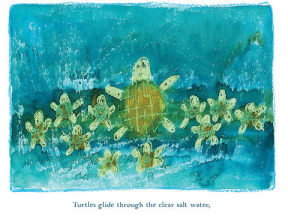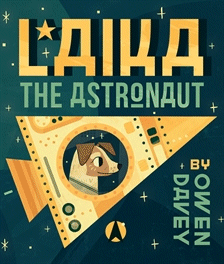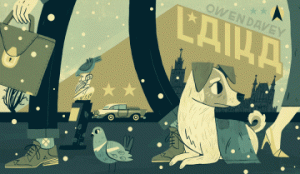Our Island
The children of Gununa, Alison Lester and Elizabeth Honey
Penguin 2014
hbk., 32pp., RRP $A24.99
9780670077687
Our island lies beneath a big blue sky,
surrounded by the turquoise sea.
Turtles glide through the clear salt water.
And dugongs graze on the banks of seagrass…
And so begins the text of a most stunning pictorial book about Mornington Island, the largest of the Wellesley group in the Gulf of Carpentaria, the result of a collaboration by the children of Gununa – the main township- and Alison Lester and Elizabeth Honey. Focusing on the stunning wildlife that inhabits both land and sea, the illustrations have been done by the children of Mornington Island State School using wax crayons and food dye wash. This makes the focal point of the pictures stand out against the background which blurs and blends as dyes do and the landscape does. Beginning with the sunrise and following through the day until the ghost crabs make patterns on the sand, the local dogs sing to the moon and the island finally sleeps, this is a celebration of life in a unique environment where the connection between the land and life is almost indivisible. Even though the text is kept to a minimum, the choice of words has been carefully selected to match the pictures giving the whole thing a poetic quality that echoes the rhythm of the day, emphasising the gentle passage of time. Overall, a sense of peace and pride just exudes from this book.
The stories of both the island and how this book came about are fascinating in themselves –all royalties and a dollar from each sale are going back to the school to fund community art projects – and provide another layer to what is already an amazing book.
Each of us lives in a unique community, whatever its geographical setting, that has its own special undercurrent of life that goes on and on providing a continuity that might be interrupted by humans but not destroyed. How fascinating it would be to have students look beneath the surface of their everyday lives to discover what is there, how it is sustained, how it is impacted by us and then use Our Island as a model to share the findings. Students would have to draw on all their senses and cross all curriculum boundaries to discover and portray the daily, unchanging routines of nature that cycle on through their lives.
A wonderful work that will probably make the reader want to book a trip to an island paradise immediately!



